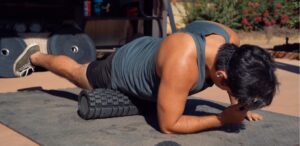
Foam rolling is a self-myofascial release technique that involves using a foam roller to apply pressure to various muscles and soft tissues in the body. It is commonly used by runners and athletes as part of their training and recovery routines. Foam rolling offers several benefits, including:
Improved flexibility and mobility: Foam rolling helps to break up muscle knots and adhesions, which can improve the flexibility and range of motion in your muscles and joints. By targeting specific areas of tightness, you can enhance your overall mobility and reduce the risk of injuries.
Enhanced muscle recovery: Engaging in intense running workouts can lead to muscle soreness and tightness. Foam rolling can help alleviate these symptoms by increasing blood flow to the muscles, reducing inflammation, and speeding up the recovery process.
Injury prevention: Regular foam rolling can help prevent common running injuries, such as iliotibial (IT) band syndrome, shin splints, and plantar fasciitis. By maintaining healthy muscle tissue and addressing tightness or imbalances, you can minimize the risk of overuse injuries.
To effectively foam roll, follow these guidelines:
- Choose the right foam roller: Foam rollers come in different densities and sizes. Beginners may prefer a softer foam roller, while more advanced users may opt for a firmer one. Experiment with different options to find the density and size that works best for you.
- Target specific muscles: Identify the areas that are tight or require attention. Common areas for runners include the calves, quads, hamstrings, IT bands, glutes, and the muscles around the hips. Roll slowly and stop on any tender spots, applying sustained pressure for around 30 seconds or until the discomfort decreases.
- Maintain proper technique: When rolling, use your body weight to apply pressure rather than forcing the roller into your muscles. Control the movement and maintain a slow and steady pace. Avoid rolling directly over joints or bony areas.
- Combine with dynamic movements: Incorporate dynamic movements, such as leg swings or lunges, along with foam rolling. This can help further mobilize the muscles and prepare them for running or other activities.
The mechanism behind why foam rolling works is still being studied, but it is believed to involve the release of tension in the fascia, a connective tissue surrounding the muscles. Foam rolling may also stimulate the Golgi tendon organs, which helps to relax the muscles and improve their flexibility.
It’s important to note that foam rolling should not replace other essential components of your training, such as proper warm-up, stretching, strength training, and rest. Additionally, if you have any pre-existing injuries or medical conditions, it’s advisable to consult with a healthcare professional before incorporating foam rolling into your routine
